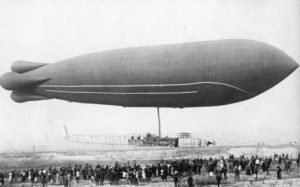15 interesting facts about airships
 Once the airships were the kings of the sky, but they had long since given way to the aircraft. Progressive for their time, they, however, turned out to be insufficiently reliable and safe, since the technologies of the last century did not allow to significantly improve them. However, in the modern world, airships, it seems, are again gradually becoming in demand.
Once the airships were the kings of the sky, but they had long since given way to the aircraft. Progressive for their time, they, however, turned out to be insufficiently reliable and safe, since the technologies of the last century did not allow to significantly improve them. However, in the modern world, airships, it seems, are again gradually becoming in demand.
In 1934, in the Soviet Union they built in a single copy the airship “USSR V-6”, the largest in the country. The length of his body reached 104.5 meters, diameter – 18.8 meters. He set a speed record of 113 km / h and in 130 hours of continuous flight flew over 4.8 thousand kilometers.
Airships, used more than a century ago, during the First World War, could rise to a height of 6-8 kilometers.
The most famous airships are, of course, Zeppelins. They are so called because they were invented by Ferdinand von Zeppelin.
The world’s first airship, built in 1852, was equipped with a steam engine.
If the weather permits, the airship theoretically can fly for weeks without landings, since it does not need such frequent refueling as airplanes.
Launched a hundred years ago, airships could cover distances of up to 12-15 thousand kilometers without landings. Such a distance is beyond the power of many modern aircraft.
In the modern world, large airships are not used, because they need a special hangar, which costs more than a hundred times more to maintain than a hangar for an aircraft of the same large size.
Most airships were cigar-shaped. However, there were other models, for example, practically spherical and even disk-shaped.
The hull volume of the largest airship models exceeded 200 thousand cubic meters.
The frame of these aircraft is not durable, therefore, unlike some kind of balloon, they can’t just land on the ground. For this they need a special mooring mast, as well as a whole team of ground personnel.
At the very first airship, which, however, never took off, the screws had to rotate manually, and this required about 80 people. No engine was provided.
The ratio of mass to payload for airships is much higher than for airplanes. Their payload can reach 40% of the total mass.
The weight of the largest airships of the last century exceeded 200 tons.
Modern airships use helium, light and safe, to fill the shell. But in the past, hydrogen was used for this purpose, because a cheap way to produce helium on an industrial scale was not yet known.
One of the aforementioned Zeppelins even made a round-the-world flight.



























